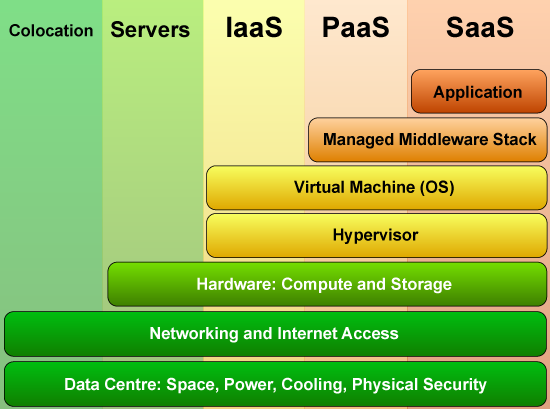Demystifying Cloud 'aaS Models
Mon, 1 Jul 2013
cloud hosting
Understanding the acronym soup of cloud products from a technical as well as business operational perspective can be mind boggling. One of our key roles is to give balanced practical advice to our existing and potential clients, made difficult with “cloud” due to the varying and sometimes contradictory usage of the terminology. This article aims to define each ‘aaS service, balance them against “traditional” hosting services, starting with the very familiar…
Colocation
For clients, this is the most “hands on” type of service we offer. We provide colocation rack space in physically secure Tier 3 London data centres, with redundant cooling, power and network connectivity. The client purchases, installs and maintains their own equipment and software – and if something goes “bang” at 3am, it is the client’s engineer’s responsibility to travel to the data centre to fix the problem.
Colocation remains ever popular, but increasingly our clients are telling us they want to dispose of the responsibility of physical maintenance, capital expense on equipment and costs of support contracts with their own third parties: they want their host to take away some headaches…
Dedicated Servers
In this scenario we provide and maintain hardware and, usually, a pre-installed operating system. This leaves the client free to concentrate on system administration and means they’ll never get called out in person to an early morning hardware collapse at the data centre.
However, studies have found that hardware is often provisioned to cope with the peak load required and hence significantly underutilised most of the time; utilising whole racks of dedicated devices is expensive, wasteful and eco-unfriendly!
What are the solutions? Take a look at this one we prepared earlier…

Easy visualisation of differing cloud models
Arguably the most significant innovation in the server world in the last decade has been virtualisation – allowing multiple virtual machines to run together on a single hardware server (hypervisor). Each virtual machine (VM, or “guest”) behaves just like a dedicated server: it has a fixed allocation of RAM and hard drive space, its own network interface cards and its own operating system.
It does however share the computational engine and components of the hardware – so whereas four web servers each using a single core might require a physical server box with its own multi-core CPU, virtualisation enables putting all four web servers on a single server with a quad-core CPU. Instantly that’s reduced space, power and cooling requirements, and shared the hardware cost between all the servers making them much less expensive to run. Alternatively, superior quality of hardware can be used at the same (or less) effective cost.
Naturally, virtualisation picked up a lot of marketing hype, and the word “cloud” was born, used, misused and abused. Here are our (we think sensible) definitions…
Infrastructure as a Service (IaaS)
As seen from the diagram above, this is the basic level of virtualisation. From an operational perspective, it offers nothing more than a dedicated server: it provides virtual machine(s) with computational and storage resources and usually a pre-installed operating system.
IaaS should however offer some technical benefits over dedicated solutions:
- High quality fast and redundant hardware
- Auto-failover on hardware failure
- The ability to quickly scale the computational requirements (CPU and RAM shares)
Further, IaaS reduces costs for smaller deployments, and is sometimes charged by the day or even hour, making scaling resources painless on the pocket as well as technically.
Responsibility: The host must support everything from the virtual machine down to the data centre, but the client is responsible for the software and any applications installed on the virtual machine; from the client’s perspective, this is identical to the dedicated server model.
Platform as a Service (PaaS)
Platform as a Service, as offered by ConnetU cloud hosting, provides all the features of IaaS combined with a large library of standardised, fully-tested and -supported virtualised components such as load balancers, web servers, database servers, replicated storage systems and so on.
Being delivered as part of the solution, these components can be rapidly assembled to create complex applications with a significantly reduced build time. For example, on our platform as a service cloud, we can build and deploy a firewalled, load balanced, high availability Apache/PHP/MySQL solution in under 20 minutes, making it readily available for the client to deploy their website.
Responsibility: The host or its partners build, test and support a standard catalogue of appliances, removing the responsibility for that system administration from the client; this frees the client to concentrate on building and deploying their critical (often proprietary) software, rather than maintaining operating system, firewall and software configurations.
Software as a Service (SaaS)
Not to be confused with SAS (the type of hard drive) or SARS (the disease), this is perhaps the most high profile “revolution” in cloud computing. In most cases it’s really a re-labelling of a type of software we already had… except previously without yet another acronym name!
SaaS is an end user service, such a CRM or ERP, that eradicates all operating and maintenance costs by delivering a fully outsourced third party solution. SaaS products provide an online interface in which clients and users interact with specialised software. Computing, storage and development is maintained by the SaaS provider in high-availability cloud environments.
Responsibility: SaaS suppliers (and/or their subcontractors) are responsible for all technical elements of their products; clients use turn-key solutions without any in-house IT expertise.
However, ownership and visibility of data are significantly reduced for SaaS customers, a situation that continues to vex IT managers and is discussed in our earlier Data Storage in Saas, Paas and IaaS Cloud Hosting article.
Come join us on: